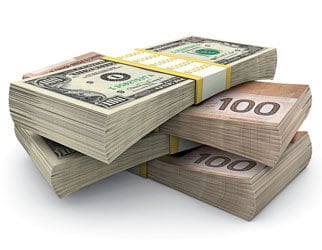Can currency-hedged ETFs protect you?
Your foreign equity holdings are likely getting smacked by the recent surge in the Canadian dollar, but before you buy currency-hedged ETFs you'll want to read this first
Advertisement
Your foreign equity holdings are likely getting smacked by the recent surge in the Canadian dollar, but before you buy currency-hedged ETFs you'll want to read this first
 If your summer plans include travel in the U.S. you’ve no doubt noticed that buying our neighbour’s currency has become a lot cheaper in the last couple of months. In early May, a loonie was worth about $0.73 USD, but as of late July it could buy you 80 shiny Lincoln pennies. That’s an increase of about 10% in less than three months.
A rising Canadian dollar is good news for snowbirds and importers, but if you hold foreign equities in your portfolio, you’ve taken a hit. Although U.S. stocks have risen in value in their native currency over that period, U.S. equity index funds saw negative returns when measured in Canadian dollars. You’ve probably also noticed some variation in the value of your international equity holdings as our dollar has experienced some wild swings in most overseas currencies over the past six months.
If your summer plans include travel in the U.S. you’ve no doubt noticed that buying our neighbour’s currency has become a lot cheaper in the last couple of months. In early May, a loonie was worth about $0.73 USD, but as of late July it could buy you 80 shiny Lincoln pennies. That’s an increase of about 10% in less than three months.
A rising Canadian dollar is good news for snowbirds and importers, but if you hold foreign equities in your portfolio, you’ve taken a hit. Although U.S. stocks have risen in value in their native currency over that period, U.S. equity index funds saw negative returns when measured in Canadian dollars. You’ve probably also noticed some variation in the value of your international equity holdings as our dollar has experienced some wild swings in most overseas currencies over the past six months.
Why the loonie shot higher. And what it means for you »
During any period when the Canadian dollar rises in value (whether against the U.S. dollar or some other foreign currency), using ETFs with currency hedging will lead to higher returns in your foreign equity investments. And whenever the Canadian dollar loses value relative to foreign currencies, the unhedged versions will win out.Sign up for our Investing newsletter »
The smart money tends to agree. The Canada Pension Plan, for example, holds billions in foreign assets and does not use currency hedging. “While currency exchange rate fluctuations may have a significant impact on our results in any given year or quarter,” the CPP Investment Board writes in a recent report, “we do not expect them to have a significant impact on the Fund’s long-term performance.” You’ll be tempted to switch back and forth. While currency hedging is often popular when the Canadian dollar is strengthening, fickle investors may be tempted to switch to unhedged ETFs when they expect the Canadian dollar to fall. If you could get the timing right this would work brilliantly. Unfortunately, reliably predicting currency movements is futile, so you’ll end up starting a cycle of guessing games. And if you’re switching back and forth between ETFs in a non-registered account you may find taxes eat up your gains even if you guess right. As always, it pays to settle on a long-term strategy and stick to it even if it occasionally suffers over shorter periods. Leave your investment portfolio alone and enjoy the other effect of a rising loonie: that cross-border shopping trip just got a lot cheaper.Share this article Share on Facebook Share on Twitter Share on Linkedin Share on Reddit Share on Email
When the CAD rises, the money you earn suddenly has more value. Since many of the products we purchase come from the US, the price of many of the our goods will fall sometime afterwards. Furthermore, it is also a good opportunity to invest in US stocks. I often take this opportunity to my convert my CAD into USD via Norberts Gambit, and use this cash to invest in US stocks as good entry opportunities present themselves. This way I am not compromising and investing in US money at the same time as US stocks.